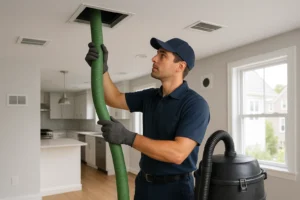Mold is one of those hidden household problems that can sneak up on anyone. It thrives in dark, damp places, and once it starts growing, it can spread quickly. Not only is it unsightly and musty-smelling, but it also poses real health risks and can damage your home’s structure. In this guide, we’ll break down everything you need to know about mold removal — from identifying it to getting rid of it safely and preventing it from coming back.
What Is Mold?
Mold is a type of fungus that grows in multicellular filaments called hyphae. It exists virtually everywhere — indoors and outdoors — and plays a vital role in breaking down dead organic matter. However, when mold grows inside your home, especially in places like basements, bathrooms, or around leaky pipes, it becomes a problem.
Mold reproduces by releasing tiny spores into the air. These spores can land on wet surfaces and begin to grow, sometimes within 24-48 hours. Common indoor molds include Cladosporium, Penicillium, Alternaria, and Aspergillus.
Why Mold Is a Problem
Mold can be more than just an eyesore. Here are some reasons why you shouldn’t ignore it:
1. Health Issues
Exposure to mold spores can cause a variety of health problems, particularly for people with allergies, asthma, or compromised immune systems. Symptoms can include:
- Sneezing and coughing
- Nasal congestion
- Skin irritation
- Eye redness and itchiness
- Respiratory issues
In rare cases, prolonged exposure to certain molds (like Stachybotrys chartarum, also known as black mold) can lead to more serious health concerns.
2. Structural Damage
Mold feeds on organic materials like wood, drywall, and insulation. Over time, it can weaken your home’s structure and lead to costly repairs if left untreated.
3. Odors and Aesthetics
That unmistakable musty smell and dark stains are signs of mold growth — both of which can make your living space uncomfortable and unappealing.
How to Identify Mold in Your Home
Before you can remove mold, you have to find it. Sometimes it’s obvious, but not always. Here’s how to detect mold:
Visual Signs
- Black, green, white, or brown spots on walls, ceilings, or floors
- Peeling or bubbling paint or wallpaper
- Water stains or discoloration
Odor
- Persistent musty or earthy smell, especially in damp areas
Hidden Mold
Mold can grow behind walls, under carpets, or inside air ducts. If you smell mold but can’t see it, you might need a professional inspection.
Mold Removal: DIY vs. Hiring a Pro
When DIY Mold Removal Is Okay
If the mold-affected area is small (less than 10 square feet), you can usually handle it yourself with proper safety gear and cleaning supplies. Just make sure there’s no major water damage involved.
When to Call a Professional
- Large or widespread mold infestations
- Mold caused by sewage or contaminated water
- Recurring mold despite previous cleaning
- Health symptoms linked to mold exposure
Step-by-Step Guide to DIY Mold Removal
Here’s how to safely remove mold from small areas in your home:
1. Protect Yourself
Wear:
- Gloves
- Goggles
- N95 respirator mask
- Long sleeves and pants
2. Ventilate the Area
Open windows and doors to allow airflow. Use fans to direct spores outside if possible, but avoid spreading them to clean areas.
3. Fix the Moisture Source
Mold can’t grow without moisture. Identify and fix any leaks, damp areas, or poor ventilation before you start cleaning.
4. Clean the Mold
Use a mixture of water and detergent, or a store-bought mold remover. Scrub the affected area with a stiff brush. Avoid mixing bleach with other cleaners, as it can release toxic fumes.
For non-porous surfaces (tile, metal, glass), bleach diluted with water can be effective. For porous materials (like drywall or carpet), it’s often best to remove and replace the affected section.
5. Dispose of Contaminated Materials
Seal moldy items like rugs or insulation in plastic bags before throwing them away. This prevents spores from spreading.
6. Dry the Area Thoroughly
Use dehumidifiers or fans to dry the cleaned area completely. Moisture left behind can cause mold to return.
Mold Prevention Tips
Once you’ve removed the mold, keeping it from coming back is key. Here are some ways to prevent mold in the future:
1. Control Humidity
Keep indoor humidity between 30-50%. Use dehumidifiers in damp areas like basements, especially in humid climates.
2. Improve Ventilation
Install exhaust fans in bathrooms and kitchens. Make sure your dryer vents to the outside.
3. Fix Leaks Quickly
Don’t let small leaks go unchecked. A dripping pipe or roof leak can turn into a mold haven fast.
4. Use Mold-Resistant Products
When renovating, consider mold-resistant drywall or paint in high-moisture areas.
5. Regular Inspections
Check for signs of water damage or mold regularly, especially after heavy rains or plumbing issues.
Final Thoughts
Mold is a common but manageable problem. With a little awareness and effort, you can spot it early, remove it safely, and keep your home clean and healthy. Whether you handle a small patch yourself or bring in the professionals for a larger job, the key is to act quickly and thoroughly. Mold won’t wait — and neither should you.


